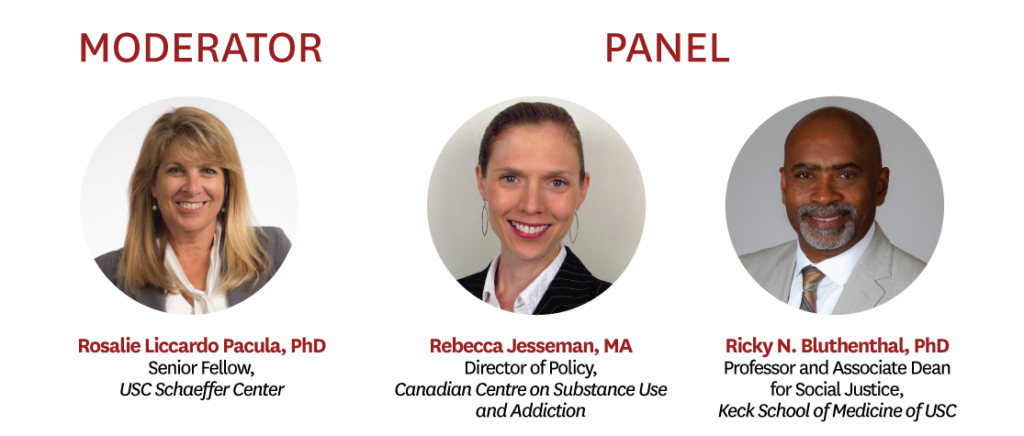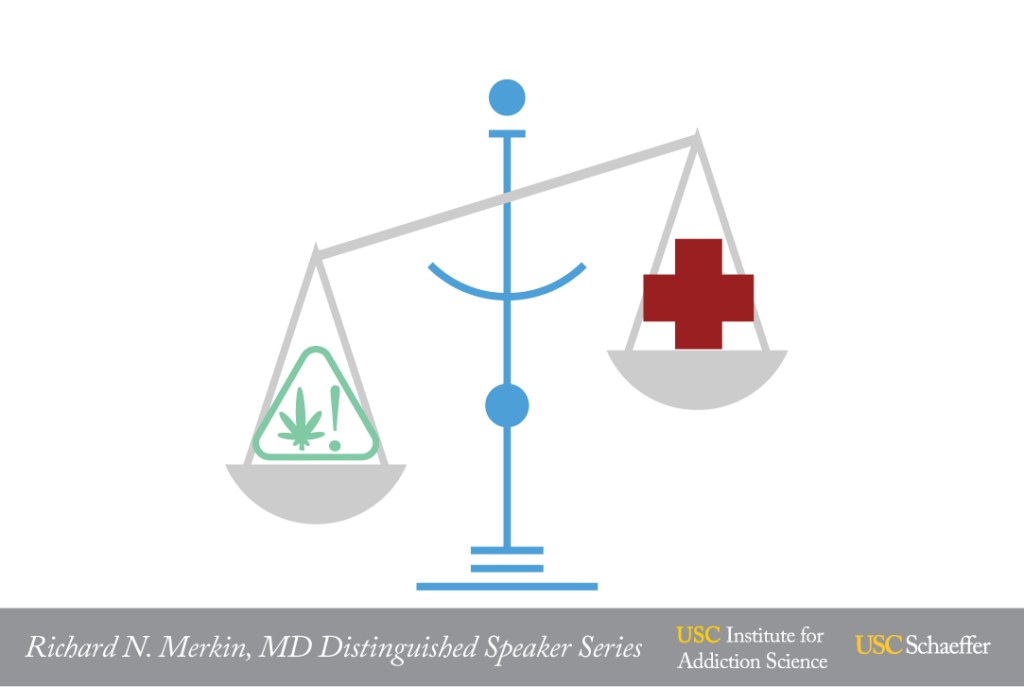Congress is moving toward federal legalization of cannabis, triggering important considerations for policymakers on issues of health, safety and equity. At present 18 states have fully legalized marijuana for recreational use and 37 states have approved its use for medical purposes. But lacking federal approval–including no guidance from the FDA–a patchwork of state regulations has grown up that leaves the health of U.S. consumers in peril. An example of a more inclusive approach can be found across the border, where Canada fully legalized cannabis in 2018 and regulates production, distribution and consumption similarly to alcohol.
Join the USC Schaeffer Center and the Institute for Addiction Science for a conversation about the challenges of regulating cannabis. Schaeffer Center Senior Fellow Rosalie Liccardo Pacula will moderate the conversation with Rebecca Jesseman, director of policy at the Canadian Centre on Substance Use and Addiction, and Ricky N. Bluthenthal, associate dean for social justice and professor in the Department of Population and Public Health Sciences at the Keck School of Medicine of USC.
- Event Date
- Wednesday, October 13, 2021
11:15 AM - 12:00 PM Pacific - Location

Rosalie Liccardo Pacula, PhD, (Moderator) holds the Elizabeth Garrett Chair in Health Policy, Economics & Law and Professor of Health Policy and Management in the USC Sol Price School of Public Policy. She was previously a senior economist at the RAND Corporation, a professor at the Pardee RAND Graduate School, served as director of RAND's BING Center for Health Economics and co-director of the RAND Drug Policy Research Center. Pacula’s research over the last 20 years has largely focused on issues related to illegal or imperfect markets (healthcare markets, insurance markets, illicit drug markets), measurement of the size of these markets, the impact they have on behavior (suppliers and consumers), and the effectiveness of policy interventions targeting behavior within these markets. More recently her work has focused on proper measurement and evaluation of opioid and cannabis policies in terms of their impacts on use, misuse and health. In work undertaken by the NIH P50 Opioid Policy Center that she co-Directs, Pacula is exploring policies influencing the diffusion of buprenorphine and naloxone, as well as the impact of OxyContin reformulation, insurance expansion, medical marijuana, prescription drug monitoring programs, and other supply restrictions. She is president of the International Society for the Study of Drug Policy (ISSDP), a faculty research fellow of the National Bureau of Economic Research (NBER), and serves on the editorial board of several journals. She received her PhD in economics from Duke University.
View Rosalie's presentation slides from the webinar.
Rebecca Jesseman, MA, is the Director of Policy at the Canadian Centre on Substance Use and Addiction (CCSA), a national non-governmental organization with a legislated mandate to provide leadership and solutions to address alcohol- and other drug-related harms. During her 15 years with CCSA, Rebecca has provided trusted counsel and expert commentary and presentations for all levels of government in Canada, and to law enforcement, educators, academia, service providers, and international policymakers. Rebecca’s areas of expertise include cannabis regulation, alternatives to the criminalization of drug use, and treatment system reform.
View Rebecca's presentation slides from the webinar.
Ricky N. Bluthenthal, PhD, is the Associate Dean for Social Justice and a Professor in the Department of Population and Public Health Sciences at the Keck School of Medicine, University of Southern California. Since 1991, he has conducted community-partnered research on risk behaviors and health promotion among people who inject drugs (PWID), men who have sex with men, and other disadvantaged populations. His current studies include an observational cohort study on the substitution of cannabis for opioids among PWID, an evaluation of the Hollywood LEAD program, and qualitative, life histories of opioid use among substance using men who have sex with men.
View Ricky's presentation slides from the webinar.
Answers from the Q&AAnswered during webinar: Childproofing of packaging is required in Canada. The province of Quebec has also restricted flavors and formats of edibles beyond the federal requirements in order to further reduce appeal to youth.
Answered during webinar: As many people live productive lives while using medications, it is not necessary the goal to eliminate all use, but to figure out how to meet the needs of patients while enabling them to engage in their regular life. Given the acute risks of opioid overdose and contaminated products within the illegal markets – which are greater than risks of cannabis use- there is a public health risk mitigation advantage to transitioning individuals from opioids to cannabis. This is no different than saying that vaping is a public health gain over smoking. While both still deliver an intoxicating substance (nicotine) and do so in different doses, the overall harm of combustible tobacco smoking (based on the current science) is greater than that of vaping. Similarly, injection opioid use is more dangerous than cannabis use, so substituting cannabis for opioids (if consistent) is preferable from a public health perspective.
Answered during webinar: To respond to the second half of the question:
- Prioritize public health and safety – not revenue generation
- Control product packaging and formats to reduce appeal to youth and accidental ingestion
- Restrict advertising to the extent possible
- Provide guidance for retail licensing, for example application standards that focus on the merit of a business case rather than a lottery, and that place restrictions on outlet density
- Provide sufficient time to establish retail structure and administrative infrastructure prior to implementation
- Mandate data collection that enables impact monitoring to inform course corrections
- Adequately resource inspection and enforcement
Answered during webinar: Licensed producers are required to account for and destroy excess supply, or lose their license. That doesn’t mean it doesn’t happen. We definitely see product coming up from the U.S. – obvious when there is an age warning of 21 when the legal age in Canada is 18! There is still a lot of illegal domestic production, and diversion from individuals who are designated to produce product for medical purposes. Illegal on-line sales also play a role. Unfortunately, the nature of the illegal market makes it difficult to quantify.
There are ongoing studies of this question, both in mice and humans, because the evidence to date is not definitive. A key question here is whether people are using less opioids when also using cannabis, in which case there could be a harm reduction benefit to supplementing opioid use with cannabis use. Dr. MJ Milloy is doing some interesting work in this area.
The point is not that we need to place limits on ethanol in its various forms, because we already have strong social norms and pretty strong science of what a standard dose is, and what having more than 3+ standardized drinks does to level of impairment. Grocery stores and liquor stores sell liquor products that in general offer 3-15 or 20 servings, not 1000’s of servings. That was simply the point being made. Even people who buy a case of wine or beer or a keg of beer are not purchasing more than 100 servings in a single transaction. If we are developing regulations to promote responsible use of cannabis, we should have sale limits that represent those objectives. Otherwise we just provide opportunities of diversion from the legal market to the illicit market and promote overconsumption.
Yes, I’m in absolute agreement that this is something the FDA is well-suited to implement and oversee, but they have to be given the authority by Congress to do so. That requires changing the legal status–either for medical and/or adult-use. I would add from Canada’s experience the importance of ensuring that the FDA or other oversight body is adequately resourced to enforce quality standards.
